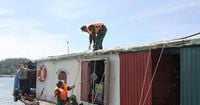As super typhoon Ragasa barrels toward the northern coast of Vietnam, government officials and coastal communities are racing against the clock to prepare for what forecasters warn could be the strongest storm of 2025 so far. With winds near the storm’s center reaching a staggering 202 to 221 kilometers per hour—classified as level 17 on the regional scale—and a projected path that threatens both mainland provinces and island districts, the stakes could hardly be higher.
On September 23, 2025, the National Steering Committee for Disaster Prevention convened an urgent online meeting to coordinate the nationwide response to Ragasa. According to baohatinh.vn, the meeting was chaired by Deputy Prime Minister Trần Hồng Hà, who did not mince words about the gravity of the situation. "Ragasa is a storm of very strong intensity, moving quickly and heading toward our mainland. All ministries, sectors, and localities must focus on proactive, early, and decisive response measures to avoid regrettable damages," he emphasized.
At that time, the center of Ragasa was located about 690 kilometers east of Lôi Châu Island, China, and was moving west-northwest at roughly 20 km/h. Meteorologists forecasted that the typhoon would bring heavy, localized rainfall, flash floods on small rivers and streams, landslides on slopes, and flooding in low-lying urban areas. The threat of flash floods and landslides loomed large, particularly for communities nestled along riverbanks and at the base of steep hills.
In Hà Tĩnh province, authorities were not taking any chances. As of September 23, a total of 3,975 vessels were safely moored at local ports and docks, while eight vessels carrying 45 workers remained at sea. Local officials reported that all vessels had been contacted and instructed to move to safe areas. The province’s large reservoirs were also under close watch, with water levels ranging from 50% to 90% of their designed capacity as of 7:00 a.m. on September 23. Hà Tĩnh’s disaster management teams were prepared to regulate water discharge to protect both infrastructure and downstream communities.
Emergency response teams and equipment were put on standby, ready to handle incidents at a moment’s notice. The provincial government issued directives to protect houses, warehouses, public offices, industrial zones, and factories. Telecommunications and electricity agencies were instructed to ensure continuous operation before, during, and after the storm, aiming to avoid the widespread outages that had plagued the region during previous typhoons.
"We have directed localities and management units to monitor the typhoon and flood situation closely and regulate water discharge to ensure the safety of infrastructure and downstream areas," said Deputy Chairman Nguyễn Hồng Lĩnh during the meeting, as reported by baohatinh.vn. He also noted that all available manpower and resources were being mobilized to harvest agricultural products that were ready, especially perishable crops like vegetables and the prized Phúc Trạch grapefruit. Around-the-clock monitoring was set up to track the storm’s progress and coordinate response efforts.
Meanwhile, in the special zones of Hải Phòng and Quảng Ninh—areas directly in Ragasa’s projected path—the sense of urgency was palpable. On September 24, local authorities in Bạch Long Vĩ, a remote frontline island far from the mainland, sprang into action. According to plo.vn, the local government reported 126 vessels operating in the area; 98 had already been safely moored in the harbor, while 28 fishing and transport vessels continued to operate at sea. Public announcements and loudspeaker warnings were issued to residents and fishermen, outlining safety measures and urging prompt action.
Border guard forces, in coordination with radar station 490, worked tirelessly to call vessels back to safe shelters and manage harbor activities. Evacuation plans were also set in motion, with a focus on moving people out of the most vulnerable zones. The authorities were especially concerned about those living in aquaculture areas, who were advised to move ashore immediately upon receiving evacuation orders.
In the Cát Hải special zone, the scale of the operation was even greater. As of September 24, there were 699 vessels and 1,513 workers operating at sea. Of these, 565 vessels and 1,119 workers had already returned to safe mooring spots, but 134 vessels with 326 workers remained at sea. On Cát Bà island, a popular tourist destination, 1,835 visitors were still present as of midday September 24—1,581 of them international tourists. Local officials had prepared to evacuate 150 households, comprising 361 people, to safe locations such as relatives’ homes, schools, health stations, and community centers before Ragasa’s landfall.
"We have informed residents in advance, especially those living on aquaculture rafts, to be ready to cooperate with authorities and evacuate to shore as soon as the city issues a sea ban," a Cát Hải official told plo.vn. The message was clear: this was not a drill, and everyone’s safety depended on swift, coordinated action.
Further north, the special zone of Vân Đồn had already seen 1,135 out of 1,350 vessels move to safety by September 24, with the remainder still making their way to shore. Task forces were deployed to ensure that all aquaculture raft owners signed commitments to evacuate all personnel by 11:00 a.m. that day. Residents living in houses at risk of roof collapse or in unsafe conditions were encouraged to move to sturdier shelters.
"We are urgently mobilizing teams to check and remind aquaculture households to bring everyone ashore for safety," said Vũ Đức Hưởng, Chairman of the Vân Đồn special zone, as cited by plo.vn. He added that special attention was being paid to areas prone to landslides and flooding, with solutions in place to protect both people and property.
On Cô Tô island, border guard units were out in force, guiding vessels to safe anchorages and working with local authorities to help residents reinforce their homes and aquaculture rafts. Emergency teams were set to operate 24/7, ready to respond to any rescue or relief needs. As of September 24, 468 vessels had been called to safe harbor, and fishermen were busy securing their boats and equipment. Aquaculture households were also shoring up their floating cages, consolidating supplies, and preparing for the worst.
Throughout these coastal and island communities, the message from national and local leaders was unequivocal: early, decisive action is the best defense against Ragasa’s destructive potential. "Focus on calling and guiding boats operating at sea to get out of dangerous areas or to safe shelters," Deputy Prime Minister Trần Hồng Hà reiterated. He also called for readiness to evacuate residents from high-risk zones, thorough inspection of critical infrastructure, and rapid deployment of resources to maintain essential services and keep transportation routes open.
As Ragasa approaches, the coming hours and days will test the resilience and preparedness of Vietnam’s northern coast. But with lessons learned from past storms, a coordinated response plan, and communities banding together, officials hope to minimize the storm’s toll and ensure that recovery can begin as soon as the winds die down.




